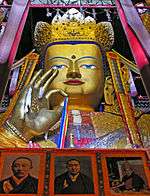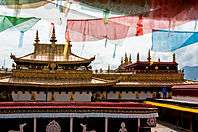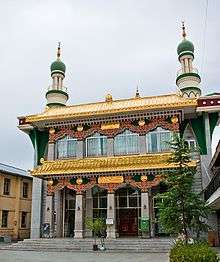Religion in Tibet
Religion in Tibet (estimates as of 2012)[1]

The main religion in Tibet has been Buddhism since its outspread in the 8th century AD. The historical region of Tibet (the areas inhabited by ethnic Tibetans) is nowadays mostly comprised by the Tibet Autonomous Region of China, and partly by the provinces of Qinghai and Sichuan. Before the arrival of Buddhism, the main religion among Tibetans was an indigenous shamanic and animistic religion, Bon, which now comprises a sizeable minority and which would later influence the formation of Tibetan Buddhism.
According to estimates from the International Religious Freedom Report of 2012, most of Tibetans (who comprise 91% of the population of the Tibet Autonomous Region) are bound by Tibetan Buddhism, while a minority of 400,000 people (12.5% of the total population of the TAR) are bound to the native Bon or folk religions which share the image of Confucius (Tibetan: Kongtse Trulgyi Gyalpo) with Chinese religion, though in a different light.[3][4] According to some reports, the government of China has been promoting the Bon religion linking it with Confucianism.[5]
There are four mosques in the Tibet Autonomous Region with approximately 4,000 to 5,000 Muslim adherents,[1] although a 2010 Chinese survey found a higher proportion of 0.4%.[2] There is a Catholic church with 700 parishioners, which is located in the traditionally Catholic community of Yanjing in the east of the region.[1]
Main religions
Tibetan Buddhism


.jpg)
Religion is extremely important to the Tibetans and has a strong influence over all aspects of their lives. Bön is the ancient religion of Tibet, but nowadays the major influence is Tibetan Buddhism, a distinctive form of Mahayana and Vajrayana, which was introduced into Tibet from the Sanskrit Buddhist tradition of northern India.[6] Tibetan Buddhism is practiced not only in Tibet but also in Mongolia, parts of northern India, the Buryat Republic, the Tuva Republic, and in the Republic of Kalmykia and some other parts of China. During China's Cultural Revolution, nearly all Tibet's monasteries were ransacked and destroyed by the Red Guards.[7][8] A few monasteries have begun to rebuild since the 1980s (with limited support from the Chinese government) and greater religious freedom has been granted – although it is still limited. Monks returned to monasteries across Tibet and monastic education resumed even though the number of monks imposed is strictly limited.[7][9] Before the 1950s, between 10 and 20% of males in Tibet were monks.[10]
Tibetan Buddhism has four main traditions (the suffix pa is comparable to "er" in English):
- Gelug(pa), Way of Virtue, also known casually as Yellow Hat, whose spiritual head is the Ganden Tripa and whose temporal head is the Dalai Lama. Successive Dalai Lamas ruled Tibet from the mid-17th to mid-20th centuries. This order was founded in the 14th to 15th centuries by Je Tsongkhapa, based on the foundations of the Kadampa tradition. Tsongkhapa was renowned for both his scholasticism and his virtue. The Dalai Lama belongs to the Gelugpa school, and is regarded as the embodiment of the Bodhisattva of Compassion.[11]
- Kagyu(pa), Oral Lineage. This contains one major subsect and one minor subsect. The first, the Dagpo Kagyu, encompasses those Kagyu schools that trace back to Gampopa. In turn, the Dagpo Kagyu consists of four major sub-sects: the Karma Kagyu, headed by a Karmapa, the Tsalpa Kagyu, the Barom Kagyu, and Pagtru Kagyu. The once-obscure Shangpa Kagyu, which was famously represented by the 20th-century teacher Kalu Rinpoche, traces its history back to the Indian master Niguma, sister of Kagyu lineage holder Naropa. This is an oral tradition which is very much concerned with the experiential dimension of meditation. Its most famous exponent was Milarepa, an 11th-century mystic.
- Nyingma(pa), The Ancient Ones. This is the oldest, the original order founded by Padmasambhava.
- Sakya(pa), Grey Earth, headed by the Sakya Trizin, founded by Khon Konchog Gyalpo, a disciple of the great translator Drokmi Lotsawa. Sakya Pandita 1182–1251 CE was the great grandson of Khon Konchog Gyalpo. This school emphasizes scholarship.
Bön
Bön, the indigenous animist and shamanic belief system of Tibet, revolves around the worship of nature and predates Buddhism.[12] Although Bön was initially the religion to which Buddha's teachings were antithetical, it now has been recognised as a legitimate religion by the 14th Dalai Lama.
According to Bon religious texts: three Bon scriptures--mdo 'dus, gzer mig, and gzi brjid—relate the mythos of Tonpa Shenrab Miwoche. The Bonpos regard the first two as gter ma rediscovered around the eleventh century and the last as nyan brgyud (oral transmission) dictated by Loden Nyingpo, who lived in the fourteenth century. In the fourteenth century, Loden Nyingpo revealed a terma known as The Brilliance (Wylie: gzi brjid), which contained the story of Tonpa Shenrab. He was not the first Bonpo tertön, but his terma became one of the definitive scriptures of Bon religion. It states that Shenrab established the Bon religion while searching for a horse stolen by a demon. Tradition also tells that he was born in the land of Tagzig Olmo Lung Ring (considered an axis mundi) which is traditionally identified as Mount Yung-drung Gu-tzeg ("Edifice of Nine Sauwastikas"), possibly Mount Kailash, in western Tibet. Due to the sacredness of Tagzig Olmo Lungting and Mount Kailash, the Bonpo regard both the swastika and the number nine as auspicious and as of great significance.
Tonpa Shenrab Miwoche visited Kongpo and found people whose practice involved spiritual appeasement with animal sacrifice. He taught them to substitute offerings with symbolic animal forms made from barley flour. He only taught according to the student's capability with lower shamanic vehicles to prepare; until with prayer, diligence, devotion and application they could incarnate to achieve sutra, tantra and Dzogchen.
Bon teachings feature Nine Vehicles, which are pathway-teaching categories with distinct characteristics, views, practices and results. Medicine, astrology, and divination are in the lower vehicles; then sutra and tantra, with Dzogchen great perfection being the highest. Traditionally, the Nine Vehicles are taught in three versions: as Central, Northern and Southern treasures. The Central treasure is closest to Nyingma Nine Yānas teaching and the Northern treasure is lost. Tenzin Wangyal Rinpoche elaborated the Southern treasure with shamanism.
Chinese ethnic religion
Most of the Han Chinese who reside in Tibet practice their native Chinese folk religion (Shendao 神道, "Way of the Gods"). There is a Guandi Temple of Lhasa (拉萨关帝庙) where the Chinese god of war Guandi is identified with the cross-ethnic Chinese, Tibetan, Mongol and Manchu deity Gesar. The temple is built according to both Chinese and Tibetan architecture. It was first erected in 1792 under the Qing dynasty and renovated around 2013 after decades of disrepair.[13][14]
Built or rebuilt between 2014 and 2015 is the Guandi Temple of Qomolangma (Mount Everest), on Ganggar Mount, in Tingri County.[15][16]
Folk religious sects
There is a Tibetan folk religious sect in Amdo County named the "Heroes of Ling", which was founded in 1981 by a Tibetan called Sonam Phuntsog, who claimed to be an incarnation of the legendary hero Gesar.[17] At its peak in the 1980s the movement had attracted converts among local communist leaders.[17] It was later banned as a disruptive and "splittist" sect.[17]
Abrahamic religions
Christianity
The first Christians documented to have reached Tibet were the Nestorians, of whom various remains and inscriptions have been found in Tibet. They were also present at the imperial camp of Möngke Khan at Shira Ordo, where they debated in 1256 with Karma Pakshi (1204/6-83), head of the Karma Kagyu order.[18][19] Desideri, who reached Lhasa in 1716, encountered Armenian and Russian merchants.[20]
Roman Catholic Jesuits and Capuchins arrived from Europe in the 17th and 18th centuries. Portuguese missionaries Jesuit Father António de Andrade and Brother Manuel Marques first reached the kingdom of Gelu in western Tibet in 1624 and was welcomed by the royal family who allowed them to build a church later on.[21][22] By 1627, there were about a hundred local converts in the Guge kingdom.[23] Later on, Christianity was introduced to Rudok, Ladakh and Tsang and was welcomed by the ruler of the Tsang kingdom, where Andrade and his fellows established a Jesuit outpost at Shigatse in 1626.[24]
In 1661 another Jesuit, Johann Grueber, crossed Tibet from Sining to Lhasa (where he spent a month), before heading on to Nepal.[25] He was followed by others who actually built a church in Lhasa. These included the Jesuit Father Ippolito Desideri, 1716–1721, who gained a deep knowledge of Tibetan culture, language and Buddhism, and various Capuchins in 1707–1711, 1716–1733 and 1741–1745,[26] Christianity was used by some Tibetan monarchs and their courts and the Karmapa sect lamas to counterbalance the influence of the Gelugpa sect in the 17th century until in 1745 when all the missionaries were expelled at the lama's insistence.[27][28][29][30][31][32]
In 1877, the Protestant James Cameron[33] from the China Inland Mission walked from Chongqing to Batang in Garzê Tibetan Autonomous Prefecture, Sichuan province, and "brought the Gospel to the Tibetan people."
During the 1905 Tibetan Rebellion Tibetan Buddhist lamas attacked, killed, and tortured French Catholic missionaries and killed Tibetans who converted to Catholicism. In 1949 Tibetan lamas killed Fr Maurice Tornay.[34]
A Christian missionary praised the Muslim Ninghai Army for its attack on the Ngoloks in Golog Tibetan Autonomous Prefecture during the Ngolok rebellions (1917–49).
Islam

Muslims have been living in Tibet since as early as the 8th or 9th century. In Tibetan cities, there are small communities of Muslims known as Kachee (Kache), who trace their origin to immigrants from three main regions: Kashmir (Kachee Yul in ancient Tibetan), Ladakh and the Central Asian Turkic countries. Islamic influence in Tibet also came from Persia. After 1959 a group of Tibetan Muslims made a case for Indian nationality based on their historic roots to Kashmir and the Indian government declared all Tibetan Muslims Indian citizens later on that year.[35] Other Muslim ethnic groups who have long inhabited Tibet include Hui, Salar, Dongxiang and Bonan. There is also a well established Chinese Muslim community (gya kachee), which traces its ancestry back to the Hui ethnic group of China. The Balti Tibetans of Baltistan are Shia Muslims.
Freedom of religion
Religion in Tibet is regulated by the laws of the People's Republic of China, which prohibits religions or use of religions for disrupting social harmony. Buddhist leaders such as Gedhun Choekyi Nyima and Tenzin Deleg remain in detention or prison.[12]
References
- 1 2 3 Internazional Religious Freedom Report 2012 by the US government. p. 20: «Most ethnic Tibetans practice Tibetan Buddhism, although a sizeable minority practices Bon, an indigenous religion, and very small minorities practice Islam, Catholicism, or Protestantism. Some scholars estimate that there are as many as 400,000 Bon followers across the Tibetan Plateau. Scholars also estimate that there are up to 5,000 ethnic Tibetan Muslims and 700 ethnic Tibetan Catholics in the TAR.»
- 1 2 Min Junqing. The Present Situation and Characteristics of Contemporary Islam in China. JISMOR, 8. 2010 Islam by province, page 29. Data from: Yang Zongde, Study on Current Muslim Population in China, Jinan Muslim, 2, 2010.
- ↑ Te-Ming TSENG, Shen-Yu LIN. The Image of Confucius in Tibetan Culture. 臺灣東亞文明研究學刊 第4卷第2期(總第8期) 2007年12月 頁169-207.
- ↑ Shenyu Lin. The Tibetan Image of Confucius. Revue d’Etudes Tibétaines.
- ↑ China-Tibet Online: Confucius ruled as a "divine king" in Tibet. 2014-11-04
- ↑ Conze, Edward (1993). A Short History of Buddhism. Oneworld. ISBN 1-85168-066-7.
- 1 2 Tibetan monks: A controlled life. BBC News. March 20, 2008.
- ↑ Tibet During the Cultural Revolution Pictures from a Tibetan People's Liberation Army's officer Archived February 13, 2009, at the Wayback Machine.
- ↑ TIBET'S BUDDHIST MONKS ENDURE TO REBUILD A PART OF THE PAST New York Times Published: June 14, 1987.
- ↑ Goldstein, Melvyn C. (2007). A History of Modern Tibet: Volume 2 The Calm before the Storm, 1951–1955. Berkeley, CA: University of California Press.
- ↑ Avalokitesvara, Chenrezig
- 1 2 United States Bureau of Democracy, Human Rights and Labor. China: International Religious Freedom Report 2007.
- ↑ World Guangong Culture: Lhasa, Tibet: Guandi temple was inaugurated.
- ↑ China-Tibet Online: Tibet's largest Guandi Temple gets repaired. 2013-03-13
- ↑ World Guangong Culture: Dingri, Tibet: Cornerstone Laying Ceremony being Grandly Held for the Reconstruction of Qomolangma Guandi Temple.
- ↑ World Guangong Culture: Wuhan, China: Yang Song Meets Cui Yujing to Discuss Qomolangma Guandi Temple.
- 1 2 3 The Heroes of Ling: The Elimination of a Tibetan Sect. Bod sjongs 'phrin deb 1982. Translation first published on: Background Papers on Tibet - September 1992, part 2, London: Tibet Information Network, 1992, pp. 30-33.
- ↑ Kapstein 2006, pp. 31, 71, 113
- ↑ Stein 1972, pp. 36, 77–78
- ↑ Françoise Pommaret, Françoise Pommaret-Imaeda (2003). Lhasa in the Seventeenth Century: The Capital of the Dalai Lamas. BRILL. p.159. ISBN 90-04-12866-2
- ↑ Graham Sanderg, The Exploration of Tibet: History and Particulars (Delhi: Cosmo Publications, 1973), pp. 23–26; Thomas Holdich, Tibet, The Mysterious (London: Alston Rivers, 1906), p. 70.
- ↑ Sir Edward Maclagan, The Jesuits and The Great Mogul (London: Burns, Oates & Washbourne Ltd., 1932), pp. 344–345.
- ↑ Lettera del P. Alano Dos Anjos al Provinciale di Goa, 10 Novembre 1627, quoted from Wu Kunming, Zaoqi Chuanjiaoshi jin Zang Huodongshi (Beijing: Zhongguo Zangxue chubanshe, 1992), p. 163.
- ↑ Extensively using Italian and Portuguese archival materials, Wu's work gives a detailed account of Cacella's activities in Tsang. See Zaoqi Chuanjiaoshi jin Zang Huodongshi, esp. chapter 5.
- ↑ Narratives of the Mission of George Bogle to Tibet, and of the Journey of Thomas Manning to Lhasa, pp. 295–302. Clements R. Markham. (1876). Reprint Cosmo Publications, New Delhi. 1989.
- ↑ Stein 1972, p. 85
- ↑ "When Christianity and Lamaism Met: The Changing Fortunes of Early Western Missionaries in Tibet by Lin Hsiao-ting of Stanford University". Pacificrim.usfca.edu. Archived from the original on June 26, 2010. Retrieved 2010-03-26.
- ↑ "BBC News Country Profiles Timeline: Tibet". 2009-11-05. Retrieved 2009-03-11.
- ↑ Lettera del P. Antonio de Andrade. Giovanni de Oliveira. Alano Dos Anjos al Provinciale di Goa, 29 Agosto, 1627, quoted from Wu, Zaoqi Chuanjiaoshi jin Zang Huodongshi, p. 196; Maclagan, The Jesuits and The Great Mogul, pp. 347–348.
- ↑ Cornelius Wessels, Early Jesuit Travellers in Central Asia, 1603–1721 (The Hague: Nijhoff, 1924), pp. 80–85.
- ↑ Maclagan, The Jesuits and The Great Mogul, pp. 349–352; Filippo de Filippi ed., An Account of Tibet, pp. 13–17.
- ↑ Relação da Missão do Reino de Uçangue Cabeça dos do Potente, Escrita pello P. João Cabral da Comp. de Jesu. fol. 1, quoted from Wu, Zaoqi Chuanjiaoshi jin Zang Huodongshi, pp. 294–297; Wang Yonghong, "Luelun Tianzhujiao zai Xizang di Zaoqi Huodong", Xizang Yanjiu, 1989, No. 3, pp. 62–63.
- ↑ http://etheses.bham.ac.uk/6344/1/Usher15PhD.pdf
- ↑ Filoni, Cardinal Fernando (May 1, 2013). "Missionary Audacity – the Mission to Tibet". Marist Messenger National Catholic Monthly. Translated by Brian Quin sm (from “Missions Etrangeres de Paris” No 478, December 2012. Marist Messenger. Retrieved 24 April 2014.
- ↑ Masood Butt, 'Muslims of Tibet', The Office of Tibet, January/February 1994


